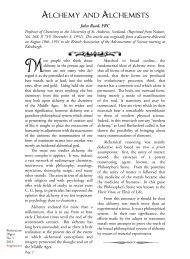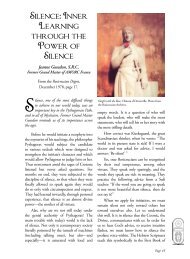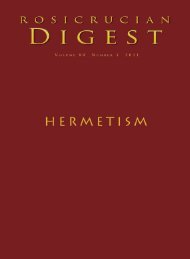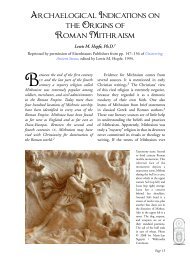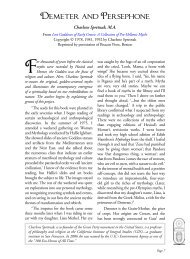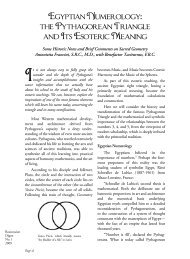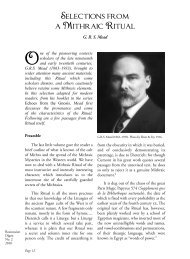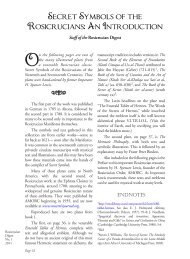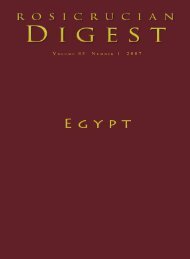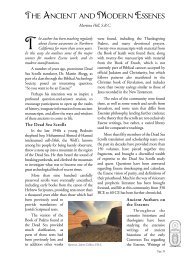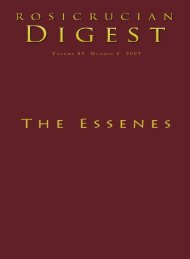The Grand Temple - Rosicrucian Order, AMORC
The Grand Temple - Rosicrucian Order, AMORC
The Grand Temple - Rosicrucian Order, AMORC
You also want an ePaper? Increase the reach of your titles
YUMPU automatically turns print PDFs into web optimized ePapers that Google loves.
Courtyard of al-Hakim mosque.<br />
In Baghdad, the ceremonies of the Abbasid<br />
Caliphs took place mainly within their palace,<br />
whereas in Cairo, Fatimid ceremonies were<br />
processional and designed to be seen by all the<br />
citizens. To the Fatimids, the world could be<br />
interpreted on many different levels, and Cairo,<br />
conceived of as almost a ritual city, was the<br />
setting for state ceremonies par excellence. <strong>The</strong>y<br />
invested their rituals with multiple meanings that<br />
were not intended to be understood by everyone<br />
who witnessed them.<br />
<strong>The</strong>re were two palace complexes: one<br />
Eastern and the other Western, with a parade<br />
ground between the two palaces, called the bayn<br />
al-qasrayn, meaning “Between the Two Palaces.”<br />
This was the main thoroughfare of the new city.<br />
Ritual had a prominent place, especially in the<br />
Eastern Palace. When seen from afar, it was said<br />
that the Eastern and Western Palaces loomed<br />
like mountains behind their high walls enclosing<br />
the ritual space where the Imam-Caliph lived.<br />
instruction known as the Majális al-Hikma<br />
(Sessions of Wisdom). Essentially, there were<br />
two types of teaching sessions: public lectures for<br />
large audiences on the záhir or exoteric subjects,<br />
and private lectures on the bátin or esoteric<br />
subjects. <strong>The</strong> people who attended the esoteric<br />
lectures referred to themselves as the awliya Allah<br />
or friends of God, or simply awliya. <strong>The</strong> Sessions<br />
of Wisdom were open to both men and<br />
women—unusual for the Islamic world. <strong>The</strong>ir<br />
cosmological speculations, which were extremely<br />
modern for those days, were at the peak of<br />
contemporary thought.<br />
<strong>The</strong> private Majális al-Hikma were held on<br />
Fridays, some also on Thursdays. Texts read at<br />
these Sessions of Wisdom had to receive the<br />
prior approval and authorization of the Imam-<br />
Caliph. All the texts were written down and<br />
archived. Some are still extant.<br />
Once the initiate or mustajib had solemnly<br />
taken the oath, he or she would undergo a stepby-step<br />
induction into wisdom. From time to<br />
time they were tested. <strong>The</strong> lessons in the bátin<br />
or esoteric wisdom were only accessible to these<br />
initiates and were held in the palace where<br />
privacy was easier to guarantee. <strong>The</strong>re was a<br />
special audience hall (majlis) used purely for<br />
this. <strong>The</strong> person who directed these sessions, the<br />
“Master” in <strong>Rosicrucian</strong> terminology, was called<br />
the Da’i al-Du’at or Supreme Da’i. It was he<br />
who led these sessions in person on a Friday. We<br />
still have a book containing the teachings taught<br />
by the most famous Supreme Da’i, Mohammed<br />
ibn al-Nu’man, in his compendium Ta’wil<br />
An Imam is a spiritual leader. Knowledge<br />
(ilm) and wisdom (hikma) are regarded as gifts<br />
from God. <strong>The</strong> believers considered the Imam-<br />
Caliph as the gift of God to humanity, who<br />
served as a guide to human beings. His duty was<br />
to teach the mystical truths of the universe,<br />
transmitting the esoteric and mystical aspects of<br />
God to everyone on earth. <strong>The</strong> form of Islam<br />
promulgated by the Fatimid rulers mixed Gnostic<br />
and messianic ideas that became interwoven<br />
with Neoplatonic philosophy.<br />
<strong>The</strong> Fatimid rulers had a high esteem for<br />
learning. During their pre-Egyptian years they<br />
had developed a series of public lectures<br />
addressed to different audiences. <strong>The</strong>se gradually<br />
developed into an elaborate program of<br />
<strong>The</strong> minaret of al-Hakim mosque.<br />
Page 11




